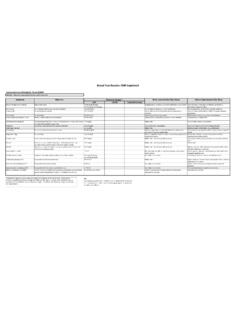Transcription of Blood Test Results: CBC Explained - IWMF
1 Blood Test results : CBC ExplainedComplete Blood Count (CBC)Definition: Measures essential components of the bloodSubstanceWhat It IsReference Ranges *What a Low Number May MeanWhat a High Number May MeanUSAUK/EUAustralia/CanadaWhite Blood cell count (WBC)Measures the total number of white Blood cells, which defend the body against infection; there are several different types of white Blood cells: lymphocytes, monocytes, neutrophils, eosinophils, and basophils4,500-10,000 cells/mcLAutoimmune diseases, immunosuppression, bone marrow failure, chemotherapy, viral infectionsInfection, inflammation, leukemia, intense exercise, stress, corticosteroidsLymphocytes, absolute (LY, abs) or percentage (LY, pct)Measures the number or percentage of lymphocytes, which are white Blood cells that include B-cells, T-cells, and natural killer cells800-5,000 cells/mcL (abs)18-45 (pct)Immunosuppression, HIV-AIDS, bone marrow failure, chemotherapyViral infections, leukemia, lymphomaMonocytes, absolute (MO, abs) or percentage (MO, pct)Measures the number or percentage of monocytes, which are white Blood cells that move out of the circulating Blood and into the tissues, where they mature into macrophages400-1,000 cells/mcL (abs)1-10 (pct)
2 Immunosuppression, bone marrow failure, chemotherapyChronic infections, autoimmune diseases, leukemiaGranulocytes, absolute (GR, abs) or percentage (GR, pct)Measures the number or percentage of white Blood cells with granules in their cytoplasm and two or more lobes in their nuclei; an inclusive term for neutrophils, basophils, and eosinophils, although neutrophils are by far the most abundant1,800-8,300 cells/mcL (abs)45-75 (pct)Immunosuppression, bone marrow failure, chemotherapyInfection, inflammation, leukemia, intense exercise, stress, corticosteroidsNeutrophils, absolute (NE, abs) or percentage (NE, pct)Measures the number or percentage of neutrophils, which are normally the most abundant circulating white Blood cells and respond quickly to infection1,800-8,300 cells/mcL (abs)45-75 (pct)Immunosuppression, bone marrow failure, chemotherapyInfection, inflammation, leukemia, intense exercise, stress, corticosteroidsEosinophils, absolute (EOS, abs) or percentage (EOS, pct)Measures the number or percentage of eosinophils, which combat parasitic infections and are involved in asthma or allergy responses 0-800 cells/mcL (abs)0-7 (pct)
3 Generally not a concernParasitic infectionsBasophils, absolute (BAS, abs) or percentage (BAS, pct)Measures the number or pecentage of basophils, which are involved in allergy responses0-100 cells/mcL (abs) (pct)Generally not a concernActive allergic responseRed Blood cell count (RBC)Measures the number of red Blood cells, which pick up oxygen from the Blood and deliver it to tissues throughout the bodyMale: million/mcLFemale: million/mcLIron, vitamin B12, or folate deficiency; bone marrow damage; leukemia or lymphoma; acute or chronic Blood loss; red Blood cell hemolysis Dehydration, renal problems, pulmonary disease, congenital heart disease, polycythemia veraReticulocytesMeasures the percentage of circulating immature red Blood not a concernAnemia, recent Blood loss, red Blood cell hemolysisHemoglobin (HgB)Oxygen-carrying pigment in red Blood cellsMale: g/dLFemale: g/dLIron, vitamin B12, or folate deficiency; bone marrow damage; leukemia or lymphoma; acute or chronic Blood loss; red Blood cell hemolysis Dehydration, renal problems, pulmonary disease, congenital heart disease, polycythemia veraHematocrit (HCT)The percentage of red Blood cells Male: : , vitamin B12, or folate deficiency; bone marrow damage; leukemia or lymphoma; acute or chronic Blood loss.
4 Red Blood cell hemolysis Dehydration, renal problems, pulmonary disease, congenital heart disease, polycythemia veraMean corpuscular volume (MCV)Average size of red Blood cells80-95 fLIron deficiencyVitamin B12 or folate deficiencyMean corpuscular hemoglobin (MCH)The amount of hemoglobin per red Blood cell23-31 pgIron deficiencyVitamin B12 or folate deficiencyMean corpuscular hemoglobin concentration (MCHC)The average concentration of hemoglobin in a given volume of red Blood cells32-36 g/dLIron deficiencySickle cell disease, hereditary spherocytosisRed cell distribution width (RDW)A measurement of the variation in red Blood cell size11-15%Generally not a concernIron deficiency, vitamin B12 or folate deficiency, recent Blood lossPlatelet count (PLT)Measures the number of platelets, which are important for Blood clotting150-400 Thousand/mcLBone marrow failure, chemotherapy, viral infections, lupus, pernicious anemia (due to vitamin B12 deficiency), leukemia or lymphoma, sequestration in the spleen, certain medicationsLeukemia, myeloproliferative disorders (which cause Blood cells to grow abnormally in bone marrow), inflammatory conditionsMean platelet volume (MPV)The average volume of a platelet; newer platelets tend to be larger than older fLAplastic anemia, thrombocytopenia Certain inherited disordersKEYmg: milligram g: gram mmol: millimole mEq: milliequivalent dL: deciliterIU: international unit L: liter mcL: microliter pg: picogram fL: femtoliterm: meter mL: milliliter* Reference ranges can vary by age, sex, methods of testing, and other factors.
5 There are no nationally established reference ranges for CMP and CBC values; instead, each laboratory tests a population and establishes its own reference ranges. Therefore, the reference ranges quoted are only approximate.
